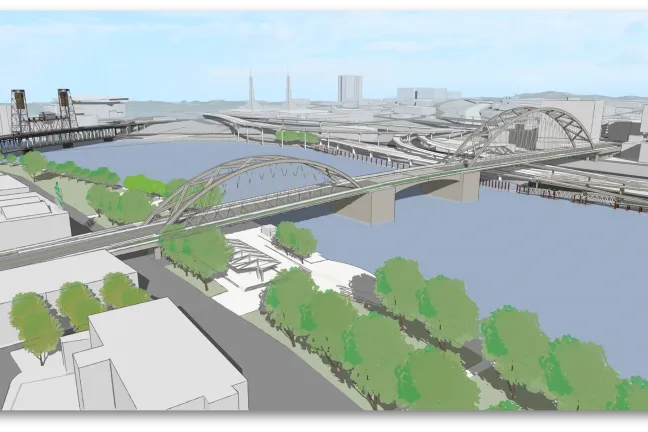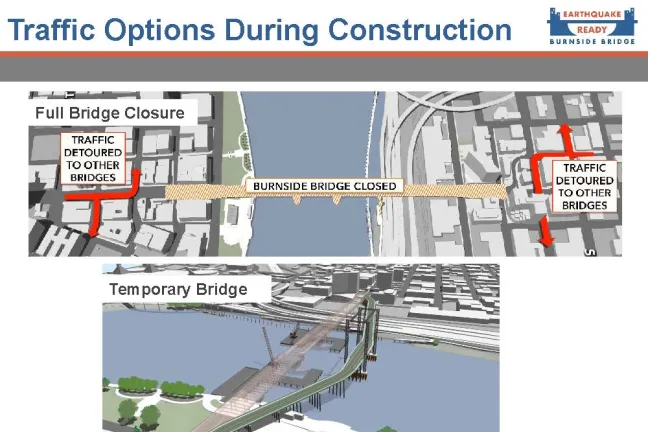Multnomah County Commissioners recommended that a new Burnside Bridge with long spans be built to ensure the bridge can be usable after a major earthquake. The October 29 vote followed recommendations by two project committees and public outreach that found strong support for the long span alternative. The Federal Highway Administration will be asked to approve the preferred alternative in fall 2021 as part of the project’s Final Environmental Impact Statement. Construction would begin in 2024, after design work is completed.
The purpose of the county’s Earthquake Ready Burnside Bridge project is to ensure that our region has at least one usable downtown bridge after a major Cascadia Subduction Zone earthquake. Other Willamette River bridges downtown are expected to be out of service for months or years after a big earthquake. Burnside was chosen because the bridge is on a regional lifeline route.
Public information officer Mike Pullen explained why the long span was recommended by the project’s Community Task Force. “Because the long span alternative has fewer support columns in hazardous soils near the river, it performs the best in a big earthquake and is the lowest cost option we studied. Fewer columns also mean there is more space under the bridge for community uses like Portland Saturday Market and the Burnside Skatepark and less impacts on the environment.”
Pullen said that public outreach this summer also found strong support for the long span, and a higher level of interest in the project overall. “People seemed much more interested in the project this year, since we are asking them to make a clear choice. We had more than 25,000 people visit our online open house and nearly 7,000 take our survey. The higher level of interest may be partly due to a pandemic bump, as more people are home and have time to take surveys.”
Pullen said 87% of people who took the survey supported the long span, which was also recommended by a committee of regional elected and appointed leaders called the Policy Group.
Managing traffic during construction
County commissioners were also asked to approve a recommendation to close the bridge to traffic during the four-to-five year construction phase, rather than construct a $90 million temporary detour bridge. “There was consensus on our task force and in our public outreach that people prefer to just close the bridge during construction,” Pullen said. “People cited the high cost of a temporary bridge, the extra two years of construction time required to build it, and the impacts it would have on the Burnside Skatepark and the environment.” Commissioners approved a resolution that includes closing the bridge during construction, with no temporary bridge.
Project manager Megan Neill explained that the project has entered a new phase that will end with the selection of the structure type for the new bridge in 2021. She shared images of different bridge types that are being considered, including a tied arch like the Sauvie Island Bridge, a cable-stayed bridge like the Tilikum Crossing, and a through truss bridge like the Hawthorne Bridge. The recommendation will also include the type of movable span, which could be a bascule like the current bridge or a vertical lift like the Hawthorne Bridge.
In a brief project update, Neill also said that the county has selected local engineering firm David Evans and Associates (DEA) to be the project’s owner representative, expanding the management team for this major capital project. “In 2021 DEA will be working to prepare requests for proposals for firms to design and build the bridge,” she said. “They will also help us develop a project labor agreement or community benefits agreement for the project.”
Before approving the preferred alternative, commissioners complimented the project team on the extensive outreach and progress made to date.
“We are at this stage that seemed so far, far away when we started this process,” said Commissioner Jessica Vega Pederson, recalling the project’s origins in 2016. “I remember when we had more than a hundred options we were considering. Thank you for including so many community voices every step of the way.”
“I appreciate the concept of the ‘Covid bump’ related to community engagement,” said Commissioner Sharon Meieran, referring to the increased public engagement during the pandemic. “It’s a tiny little silver lining for this time.”
Commissioner Lori Stegmann summed up her rationale for supporting the long span as the preferred alternative. “It makes sense to me to choose the least expensive option, that’s the most stable, with the least barriers.”


